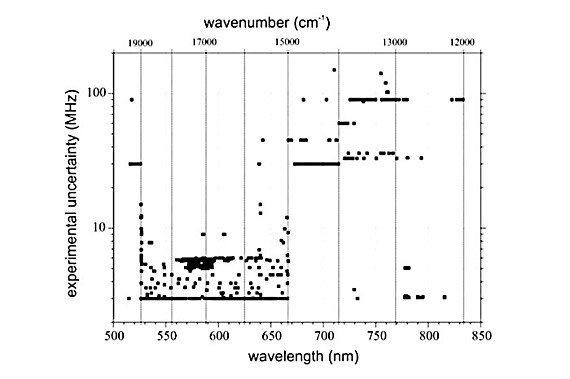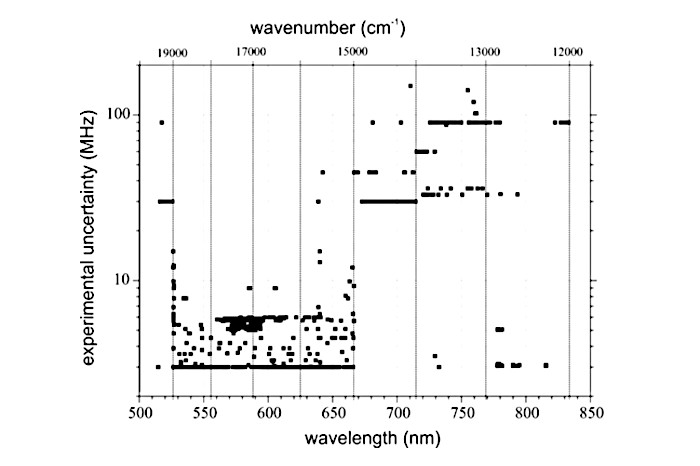Secondary Frequency Standard
Application of lasers in high precision spectroscopy and technical areas like communication demand for precisely known frequencies, which can be used as references either to measure the laser's frequencies or to stabilize the laser frequency with respect to them.
Molecules usually have wide spectra with many spectral lines, whose frequencies nevertheless mostly can be described by simple physical models. So it is possible to determine the parameters of this "model molecule" with few highly precise measurements, and then use the model for highly accurate and reliable prediction of further lines of the spectrum, which then can be used as frequency references.
The iodine molecule (127I2) is especially well suited for reference lines in the visible, because its strong and dense absorption spectrum extends from about 900 nm in the near infrared (NIR) to about 500 nm in the blue-green. The vapour pressure at room temperature is some ten Pa [12], so it can conveniently be used at room temperature in evacuated absorption cells made of glass or quartz (details of cell construction, as we use it for the NIR). Lasers stabilized to iodine lines have been demonstrated, which offer a relative stability Δν/ν of their frequency ν of better than 10-12.
High precision calibrations of lines of the iodine molecule were performed in the near infrared between 778 nm and 815 nm [5-9]. Including data from literature, a new representation of the quantum number dependence of the hyperfine structure on the vibration and rotation of both electronic states using physical models was developed [4]. Including all known high precision iodine lines in the visible, data from the high resolution iodine atlas by Kato [10] and unblended lines of the well known iodine atlas by Gerstenkorn and Luc [11], a high precision data representation for the rovibrational structure using molecular potentials has been completed [3] which was recently extended in cooperation with the Laser Centre of the VU Amsterdam to cover also the isotopologues 129I2 and 127I129I [1,2].
The uncertainties of transition frequencies available from literature are widely distributed. The figure below gives an overview over the data and their uncertainties used for the model description:



The model is based on the description of the level energies as the eigen energies in molecular potentials. The potentials are represented by a power series, whose parameters are fitted to the data. The histogram of the residuals of the final fit, normalized to their experimental uncertainties, fits well to a gaussian distrubution, which has a full width at half maximum of about one. This means that more than 90 % of the residuals fall in the range of ± their experimental uncertainty. Thus as a rule of thumb the expected 2σ uncertainty of predicted frequencies is just the experimental uncertainty of the data put in. Therefore, between 525 nm and 666 nm one can expect ± 3 MHz as the 2σ uncertainty of predicted lines for calibration. In the range from 776 nm to 815 nm the uncertainty is even less, because in this restricted range a different model is used. For details see [1,3].
With the available data already [3] also Born-Oppenheimer corrections (BOC) were investigated. These small contributions differ between different isotopomers according to the masses of the atoms. However, only a handful of measurements of the isotopomers 129I2 and 127I129I existed in literature at that time, and reliability of the BOC's remained unclear.
The situation has been substantially improved by the cooperation with Prof. Wim Ubachs and his collegues from the Laser Centre of Vrije Universiteit Amsterdam. Extensive and systematic investigations of the isotopomers 129I2 and 127I129I were performed with the goal of better determination of the BOC. The results have been published in [1].
For the hyperfine structure the measurements allowed for a general model description of the hyperfine parameters valid for all three isotopologues [2].
Ongoing interest of the international community regarding the iodine spectrum as a useful frequency reference is a good motivation to continue joint investigations with other groups [0]. A simulation program called "IodineSpec" containing these models was developed for convenient calculation of calibration lines for the natural isotopomer 127I2 and for the other isotopologues mentioned above as well.
A present version of the program can be made available on request to Prof. Tiemann (see contact box below).
Related Literature
[0] Chun-Chieh Liao, Kuo-Yu Wu, Yu-Hung Lien, Horst Knöckel, Hsiang-Chen Chui, Eberhard Tiemann, and Jow-Tsong Shy, Precise frequency measurements of 127I2 lines in the wavelength region 750–780 nm, J. Opt. Soc. Am. B, Vol. 27, Issue 6, pp. 1208-1214 (2010) doi:10.1364/JOSAB.27.001208
[1] E.J. Salumbides, K.S.E. Eikema, W. Ubachs, U. Hollenstein, H. Knöckel, E. Tiemann
Improved potentials and Born-Oppenheimer corrections by new measurements of transitions of 129I2 and 127I 129I in the B3Π0+u - X1Σ+g band system
Eur. Phys. J. D 47, 171–179 (2008), DOI: 10.1140/epjd/e2008-00045-y
[2] E.J. Salumbides, K.S.E. Eikema, W. Ubachs, U. Hollenstein, H. Knöckel, and E. Tiemann,
The hyperfine structure of 129I2 and 127I129I in the B3Π0+u - X1Σ+g band system,
Mol Phys. 104, 2641–2652 (2006)
[3] H. Knöckel , B. Bodermann, E. Tiemann,
High precision description of the rovibronic structure of the I2 B-X spectrum,
Eur. Phys. J D 28,199(2004)
Erratum: there are misprints in table 4, look here for the correct one.
[4] B. Bodermann, H. Knöckel , E. Tiemann,
Widely usable interpolation formulae for hyperfine splittings in the 127I2 spectrum,
Eur. Phys. J. D19, 31 (2002)
[5] B. Bodermann, M. Klug , U. Winkelhoff, H. Knöckel, E. Tiemann,
Precise frequency measurements of I<sub>2<sub/> lines in the near infrared by Rb reference lines,
Eur. Phys. J. D 11, 213-225 (2000)
[6] B. Bodermann, G. Bönsch, H. Knöckel , A. Nicolaus, E. Tiemann,
Wavelength measurements of three iodine lines between 780 nm and 795 nm,
Metrologia 35, 105 (1998)
[7] B. Bodermann, M. Klug, H. Knöckel , E. Tiemann , T. Trebst, H.R. Telle,
Frequency measurement of I2 lines in the NIR using Ca and CH4 optical frequency standards,
Appl. Phys. B67, 95 (1998)
[8] H. Knöckel , B. Bodermann, E. Tiemann,
High precision measurements of hyperfine structures near 790 nm of I2,
Z. Phys. D: Atoms, Molecules and Clusters, 37(1), 43 - 48 (1996)
[9] S. Kremser, B. Bodermann, H. Knöckel , E. Tiemann,
Frequency stabilization of diode lasers to hyperfine transitions of the iodine molecule,
Opt. Comm. 110, 708 (1994)
[10] H. Kato et al.
Doppler free high resolution spectral atlas of the iodine molecule,
Japan Society for the promotion of science (2000)
[11] S. Gerstenkorn, P. Luc, Atlas du spectre d’absorption de la mol´ecule d’iode,
Laboratoire Aim´e Cotton, CNRS II, Orsay (France),
14 000 cm−1 – 15 600 cm−1 (1978),
15 600 cm−1 – 17 600 cm−1 (1977),
17 500 cm−1 –20 000 cm−1 (1977);
S. Gerstenkorn, J. Verges, J. Chevillard,
Atlas du spectre d’absorption de la mol´ecule d’iode,
Laboratoire Aim´e Cotton, CNRS II, Orsay (France),
11 000 cm−1 – 14 000 cm−1 (1982)
S. Gerstenkorn, P. Luc, Atlas du spectre d'absorption de la molécule d'iode
Complément "Identification des transitions du systeme (B-X) de la molecule
d'iode et facteurs deFranck-Condon" (1986),
Laboratoire Aimé Cotton, CNRS II
[12] vapour pressure of iodine:Landolt-Börnstein, "Zahlenwerte und Funktionen aus Physik, Chemie, Astronomie..."
II Band, 2. Teil, Teilband 2a, 6. Ausgabe, Springer, Berlin (1960)
30167 Hannover
30167 Hannover


